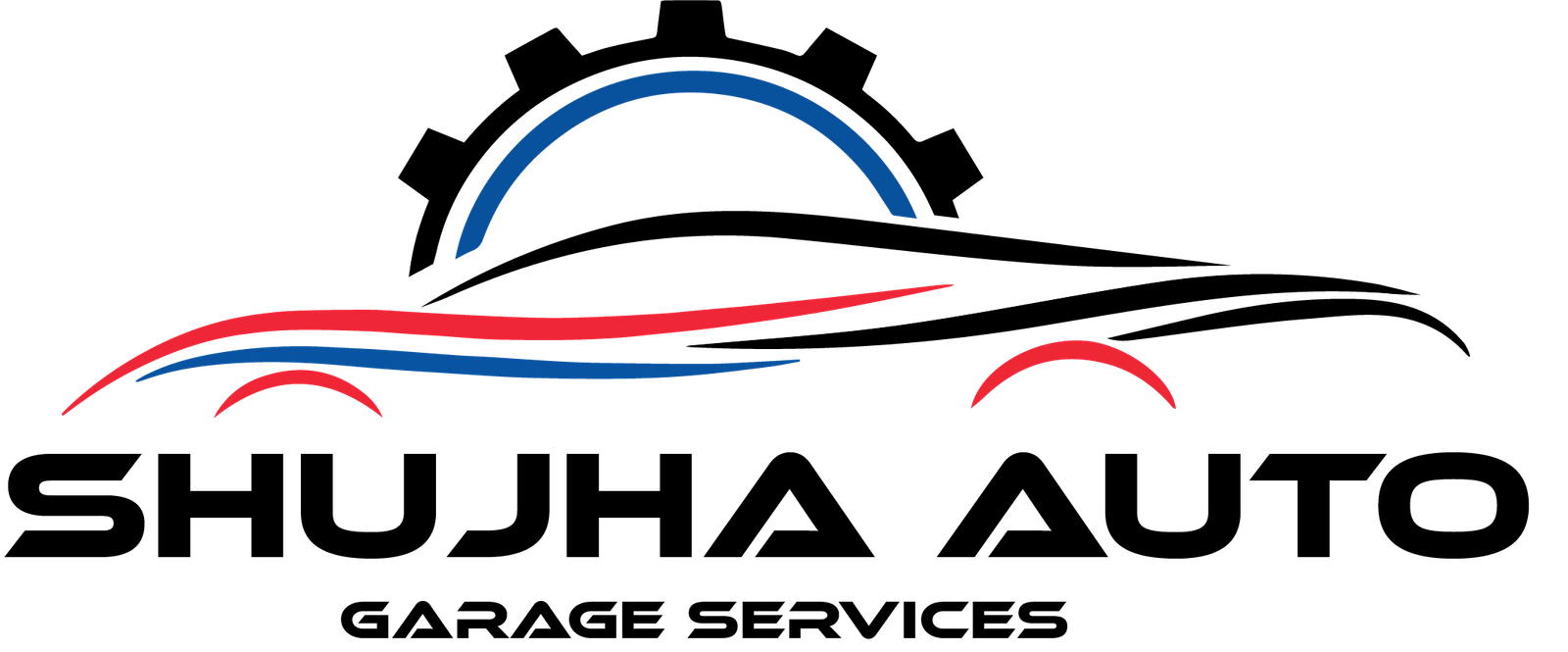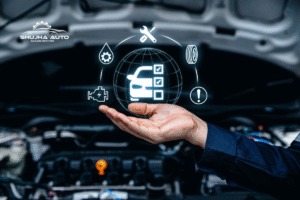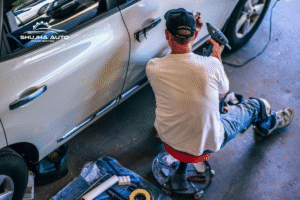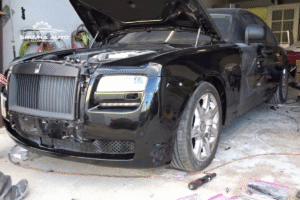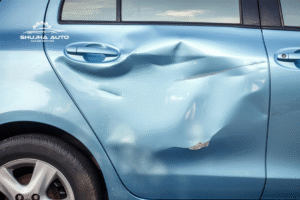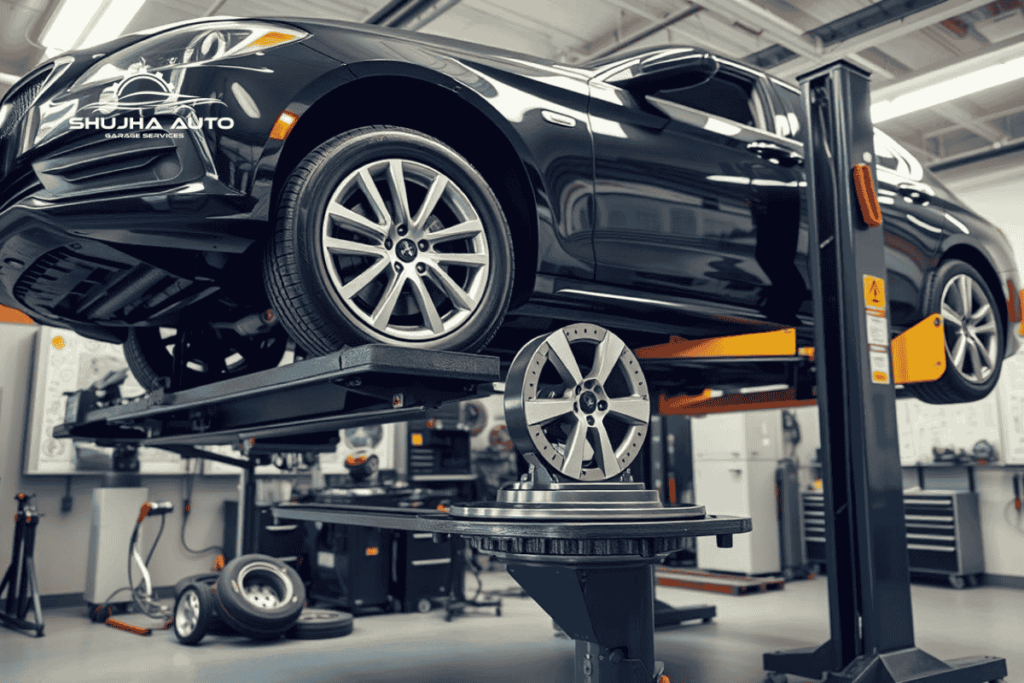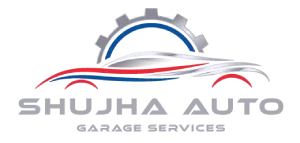Ensure your car alignment is done right with expert service. Improve your vehicle’s performance and extend tire life with professional alignment services.
Keeping your car’s wheels aligned is key for its best performance, safety, and life span. At Shujah Auto Garage, we’re proud to offer top-notch Car alignment services. Our team uses the latest tools and methods to ensure your car drives smoothly and efficiently.
If your tires wear unevenly, your car pulls to one side or handles poorly, we can help. Our expert service fixes these problems and brings back your car’s top performance. We know how important proper alignment is for your safety and your car’s health. That’s why we aim to provide outstanding service and align your car just right, making every drive safer and more comfortable.
Key Takeaways
- Expert car alignment service for optimal vehicle performance and safety
- State-of-the-art equipment and cutting-edge techniques used by skilled technicians
- A comprehensive solution to address issues like uneven tire wear and poor handling
- Alignment adjusted to manufacturer specifications for a smoother, more stable ride
- Importance of professional alignment service for overall vehicle health and longevity
Understanding Car Alignment: What Every Driver Should Know
As a driver, knowing about wheel alignment is key. It keeps your car running well, and safely and saves fuel. The angles of your wheels help your car stay straight on the road.
The main angles to know are caster, camber, and toe. Caster affects how your car steers and stays straight. Camber impacts tire wear and how your car corners. Toe influences your car’s handling and stability.
When your wheels are aligned right, your car drives smoothly. It also wears out tires less and saves fuel. But, if your alignment is off, you might face problems like uneven tire wear and poor fuel economy.
Maintaining proper wheel alignment is essential for the overall performance and longevity of your vehicle.”
Knowing about wheel alignment helps you decide when to get your car checked. Regular checks and adjustments can make your tires last longer. They also improve your car’s handling and make driving better.
In the next parts, we’ll explore why wheel alignment matters. We’ll also talk about signs your car needs service and the benefits of keeping your alignment in check.
Why Regular Wheel Alignment Matters for Vehicle Safety
Keeping your wheels aligned is more than just making your car look good. It’s key to keeping you safe on the road. It helps your car stay stable, handle well, and steer smoothly.
Out-of-alignment wheels can hurt your car’s performance and safety. They can make your car pull to one side, making it hard to control. This increases the chance of accidents. Also, bad alignment can wear out your tires too fast and unevenly, making the road even more dangerous.
Getting your wheels aligned regularly is vital for your car’s safety. It ensures your car handles better and stays stable. This is super important in emergencies or when driving on tough roads.
| Alignment Issue | Impact on Vehicle Safety |
| Uneven Tire Wear | Reduced traction and increased risk of blowouts or hydroplaning |
| Pulling or Drifting | Difficulty maintaining control and increased risk of accidents |
| Poor Steering Response | Reduced responsiveness and increased risk of loss of control |
Fixing alignment problems quickly keeps your car safe and reliable. This gives you peace of mind every time you drive.
The Complete Process of Professional Car Alignment Service
Keeping your car safe and running well is key. A good car alignment service is essential. It’s a detailed process done by skilled techs with the latest tools.
The first step is a thorough alignment inspection. Techs check the suspension, steering, and wheel position for any problems. This step is crucial for making the right adjustments.
- Suspension and Steering Inspection:
Techs examine the suspension system, like ball joints and tie rods, to make sure they’re working right. - Computerized AlignmentMeasurement:
Advanced computerized alignment tools measure the wheel angles. This shows how much the car is off. - Adjustment Procedures:
Based on the findings, techs make the needed adjustments to get the car back in line.
The last step is a test drive. This checks if the car handles and rides smoothly again. This care helps your tires last longer, saves fuel, and makes driving better.
“Regular car alignment service is essential for maintaining the safety and performance of your vehicle, ensuring a smooth, comfortable, and efficient ride.”
| Key Steps in Professional Car Alignment Service | Description |
| Suspension and Steering Inspection | A comprehensive examination of suspension components and steering system to identify any issues contributing to misalignment. |
| Computerized Alignment Measurement | Precise measurement of wheel angles, including camber, caster, and toe, using state-of-the-art computerized alignment equipment. |
| Adjustment Procedures | Meticulous adjustment of suspension, steering, and other related systems to bring the wheels back to the manufacturer’s recommended specifications. |
| Test Drive and Inspection | Final test drive to ensure the vehicle’s handling and stability have been restored to optimal levels. |
Common Signs Your Car Needs Alignment Service
Regular wheel alignment is key for your car’s best performance and safety. Spotting early signs of misalignment can prevent bigger issues. Here are some common signs your car might need an alignment check.
Uneven Tire Wear: Uneven tire wear is a clear sign of wheel misalignment. If one side of your tires wears down faster, it means your wheels are not aligned right.
Vehicle Pulling to One Side: If your car pulls to one side while driving straight, it’s a sign of misalignment. This can make steering hard and unsafe.
Off-Center Steering Wheel: An off-center steering wheel when driving straight is another sign. It means your wheels are not aligned, causing your car to wander.
- Uneven tire wear
- Vehicle pulling to one side
- Off-center steering wheel
Knowing these signs helps you fix wheel misalignment early. Regular checks and services keep your car safe and efficient. They also prevent costly repairs later on.
Location: Please Visit Our Shujha Auto Garage
How Often Should You Get Your Wheels Aligned?
Keeping your wheels aligned is key for your car’s smooth running. But, how often to align them is tricky. It depends on several things. Let’s explore the alignment frequency, maintenance schedule, and manufacturer recommendations.
Most car makers suggest aligning your wheels every 12 months or 12,000 miles. This is for average driving and wear. But, some situations might need more frequent checks:
- Hitting potholes or curbs can mess up your alignment, even if you don’t notice it right away.
- Changing your car’s suspension, like bigger tires or a lift kit, can also mess with alignment.
- Driving on rough roads, like construction zones, can make alignment service more urgent.
If you see signs of misalignment, like uneven tire wear or the steering wheel off-center, get it checked and aligned fast. Ignoring these signs can damage your tires and suspension. It can also hurt your car’s fuel efficiency and handling.
For your car’s alignment maintenance schedule, always follow the manufacturer‘s advice. They know your car best. By doing this, you keep your wheels aligned, extend your tires’ life, and keep your car running well.
The Cost Benefits of Regular Alignment Maintenance
Keeping your wheels aligned is key for your car’s safety and performance. It also saves you money in the long run. Regular alignment helps your tires last longer, improves fuel efficiency, and avoids costly repairs.
One big advantage of regular alignment is longer-lasting tires. When your wheels are aligned right, your tires wear evenly. This means you won’t need to replace them as often, saving you money and reducing waste.
Also, proper alignment makes your car more fuel-efficient. Misaligned wheels make your car work harder, using more fuel. Keeping your wheels aligned helps you save on gas and lower your fuel costs.
The biggest savings come from avoiding expensive repairs. Misaligned wheels can damage your car’s suspension and steering. Regular alignment helps prevent this, saving you from costly repairs later on.
Investing in regular wheel alignment is like a preventative maintenance plan for your vehicle. It pays dividends in the long run through extended tire life, improved fuel economy, and the avoidance of more costly repairs.” – John Smith, Automotive Maintenance Expert
In conclusion, regular alignment maintenance offers clear cost benefits. It ensures a smoother, safer, and more affordable driving experience for years to come.
Professional vs. DIY Alignment: What’s Best?
When it comes to keeping your vehicle’s alignment in check, you have two choices. You can either go for a professional service or try it yourself. Knowing the pros and cons of each option can help you decide what’s best for you and your wallet.
Professional alignment services use advanced alignment tools and expertise for precise adjustments. Trained technicians can spot and fix problems quickly. This ensures your vehicle handles well and your tires last longer, saving you money in the long run.
DIY alignment might appeal to those who enjoy tinkering with their cars. But, it needs specialized knowledge, tools, and a lot of time. Without the right tools and expertise, you risk making mistakes that could harm your car’s safety and performance.
| Professional Alignment | DIY Alignment |
| Utilizes advanced equipment and expertise | Requires specialized knowledge and tools |
| Ensures precise adjustments | Risk of improper adjustments |
| Cost-effective in the long run | Potentially more affordable upfront |
| Saves time and hassle | Time-consuming process |
The choice between professional and DIY alignment depends on your skills, tools, and what matters most to you. While DIY can be fulfilling, most drivers find it wise to leave their car’s alignment to the pros. This ensures your vehicle is safe and runs smoothly.
Impact of Road Conditions on Wheel Alignment
Drivers often don’t realize how road conditions affect their vehicle’s wheel alignment. Potholes and speed bumps can mess with the balance of our wheels. This can lead to expensive alignment problems and safety issues.
Potholes can damage your vehicle’s suspension, causing wheels to misalign and tires to wear unevenly. Speed bumps stress your car’s alignment, causing it to drift over time. Off-road driving also affects alignment, requiring more frequent maintenance.
| Road Condition | Impact on Wheel Alignment | Potential Consequences |
| Potholes | Disrupts the suspension system, causing wheels to become misaligned | Uneven tire wear, decreased fuel efficiency, compromised handling and safety |
| Speed Bumps | Puts excessive stress on the alignment, leading to a gradual drift over time | Increased wear and tear on suspension components, decreased vehicle stability |
| Off-Road Driving | Challenges the alignment with uneven terrain and sudden impacts | Accelerated alignment wear, potential damage to steering and suspension parts |
To fight against these road challenges, regular wheel alignment checks are key. Being proactive about alignment maintenance helps your tires last longer. It also makes driving smoother, safer, and more efficient.
Protecting your vehicle’s wheel alignment is a crucial aspect of maintaining its overall performance and longevity.
Advanced Alignment Technology and Modern Vehicles
Today’s cars, especially electric and hybrid ones, need precise wheel alignment more than ever. The 3D alignment system is a top-notch solution. It uses advanced cameras and sensors to check each wheel’s exact position.
3D alignment systems also check Advanced Driver Assistance Systems (ADAS). These include features like lane departure warning and automatic emergency braking. They need precise alignment to work right. This is key for safe driving.
Electric and hybrid cars have special needs for alignment. They have a lower center of gravity and different parts. Experts in electric vehicle alignment are needed to keep these cars running well.
- 3D alignment systems provide unparalleled precision in wheel positioning analysis
- ADAS calibration is a crucial part of the modern alignment process
- Electric and hybrid vehicles require specialized 3D alignment and ADAS calibration services
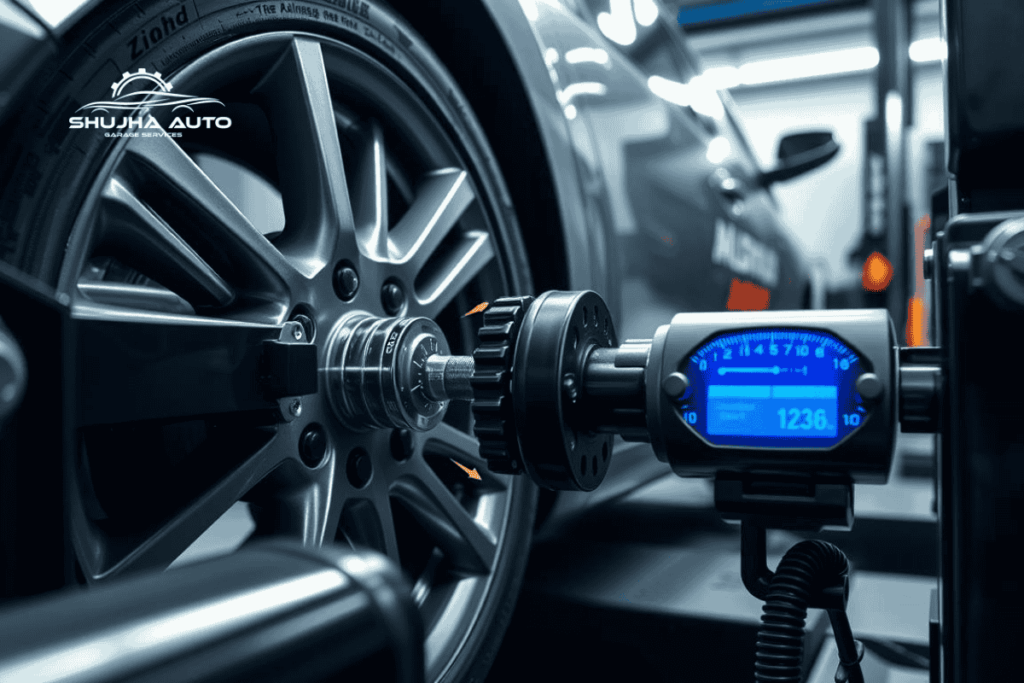
“Proper wheel alignment is not only crucial for the safety of modern vehicles, but it also plays a significant role in their overall performance and efficiency.”
The car world is always changing, and so is the need for advanced alignment tech. By picking a reliable alignment service, car owners can make sure their vehicles are ready for today’s roads and tomorrow’s tech.
Alignment Services for Different Vehicle Types
Wheel alignment needs to change a lot depending on the vehicle type. Cars, trucks, and SUVs all have their own special needs. These needs are important for the vehicle’s performance and safety.
Car Alignment:
Cars like sedans and hatchbacks need a basic four-wheel alignment. This makes them more fuel-efficient, better to drive and helps tires last longer.
Truck Alignment:
Trucks, big and small, need more detailed alignment services. Their size and heavy loads stress the suspension. So, they need special adjustments to stay stable and controlled.
SUV Alignment:
SUVs need a balance between car and truck alignment. They must handle off-road and on-road driving well. A precise four-wheel alignment is key for a smooth ride.
Performance Vehicle Alignment:
High-performance cars need the most precise alignment. They have advanced suspensions and wide tires. Specialized knowledge and tools are needed to align them for top performance.
| Vehicle Type | Alignment Needs | Key Considerations |
| Cars | Four-wheel alignment | Improve fuel efficiency, handling, and tire lifespan |
| Trucks | Comprehensive alignment | Address suspension stress from larger sizes and heavier loads |
| SUVs | Four-wheel alignment | Balance on-road and off-road performance |
| Performance Vehicles | Specialized alignment | Accommodate advanced suspension systems and wider tires |
It’s important to know the specific alignment needs of your vehicle. A skilled car alignment specialist can ensure your vehicle’s wheels are aligned right. This is true for any type of vehicle.
The Connection Between Tire Wear and Alignment
Proper wheel alignment is key for your vehicle’s safety and tire life. Misaligned wheels cause uneven tread wear patterns, early tire wear, and alignment-related tire damage.
Out-of-alignment wheels make tires drag or pull in different directions. This uneven wear leads to poor traction and less fuel efficiency. You’ll also need to rotate and replace tires more often.
| Alignment Issue | Tread Wear Pattern | Impact on Tire Lifespan |
| Toe Misalignment | Excessive wear on the inside or outside of the tires | Significantly reduced tire life |
| Camber Misalignment | Uneven wear across the width of the tires | Moderate reduction in tire life |
| Caster Misalignment | Irregular wear pattern, often with one side wearing faster than the other | Moderate reduction in tire life |
Regular tire rotation and wheel alignment checks are vital. They ensure even tread wear and extend your tires’ life. Proper alignment means a smoother ride, better fuel efficiency, and safer driving.
Proper wheel alignment is one of the most overlooked maintenance tasks, but it’s critical for the health and longevity of your tires.
Choosing the Right Alignment Service Provider
Choosing the right certified technicians for your wheel alignment is key. Proper alignment makes your ride smooth and stable. It also saves your tires and improves fuel efficiency. But, with many options, how do you pick the right one?
First, look at the alignment equipment they use. A good shop has the latest technology, like computerized machines. These tools find and fix any issues with your vehicle’s parts.
- Check if the technicians are certified and experienced. Good shops have trained experts who do great work.
- Read customer reviews They show how happy customers are and the shop’s quality.
- See if they offer a warranty on their services. A good shop guarantees their work, giving you confidence.
By choosing a trusted alignment service, your vehicle is in safe hands. With the right skills and tools, you’ll enjoy a safe and efficient ride for a long time.
Choosing the right alignment service provider can make all the difference in the performance and longevity of your vehicle.
Post-Alignment Care and Maintenance Tips
Keeping your car’s alignment right is key after a professional alignment service. To keep your vehicle’s alignment perfect, follow these easy tips:
- Regularly check your suspension care. Look for worn or damaged parts that can lead to misalignment.
- Watch your tire pressure maintenance Low or uneven tire pressure can cause wheels to get out of alignment.
- Steer clear of potholes, curbs, and other road hazards that can knock your wheels out of alignment.
- Drive carefully and pay attention to how your car handles. Any changes might mean you need a re-alignment.
- If you see uneven tire wear, get your alignment checked right away to avoid more damage.
By following these simple steps, you can keep your vehicle’s alignment in check. This helps your tires last longer. Regular care is the secret to keeping your car safe and efficient on the road.
Proper alignment is essential for your vehicle’s handling, fuel efficiency, and overall performance. Taking the time to maintain your car’s alignment can save you a lot of money in the long run.
The Environmental Impact of Proper Wheel Alignment
Proper wheel alignment is key for your vehicle’s performance and longevity. It also has big environmental benefits. By aligning your wheels, you help make driving greener and cut down on carbon emissions.
One big plus of proper wheel alignment is improved fuel efficiency. When your wheels are aligned, your engine doesn’t have to work as hard. This means you use less fuel and produce fewer emissions, which is good for the planet.
Also, well-aligned wheels mean your tires last longer. This reduces the amount of tire waste in landfills. Proper alignment helps your tires wear evenly, so they last longer before needing to be replaced.
Another benefit is reduced emissions. Aligned wheels mean less rolling resistance, so your engine doesn’t have to work as hard. This leads to less fuel use and fewer emissions, making your driving more eco-friendly.
Proper wheel alignment is a simple and cost-effective way to reduce your vehicle’s environmental impact and contribute to a greener future.
In summary, proper wheel alignment has clear environmental benefits. It boosts fuel efficiency, cuts down on tire waste, and lowers emissions. By prioritizing wheel alignment, you’re taking a small but significant step towards a greener driving experience.
Conclusion
In this article, we explored why proper wheel alignment is key for your vehicle’s performance and safety. It’s not just a luxury, but a must for every driver. It ensures your car or truck runs at its best.
Keeping your wheels aligned improves your vehicle’s handling and stability. It also helps save fuel, makes your tires last longer, and keeps you safe on the road. By fixing common alignment problems and following service schedules, you get the most out of your vehicle. You’ll enjoy a smoother, more reliable drive.
As you keep driving, remember to always prioritize wheel alignment in your car care routine. This keeps your vehicle performing well and lasts longer. It also makes driving safer and better for the environment. Taking care of your vehicle means it will take care of you for years, offering dependable, comfortable, and affordable rides.
FAQ
What are the key alignment angles that affect my vehicle’s performance?
The main angles are caster, camber, and toe. These angles are key for your vehicle’s handling and tire wear.
How does proper wheel alignment improve vehicle safety?
Proper alignment makes your vehicle more stable and easier to steer. This improves safety on the road.
What happens during a professional car alignment service?
A professional service checks your vehicle’s alignment. Then, they make precise adjustments with advanced tools.
What are the common signs that my car needs an alignment?
Look for uneven tire wear, the car pulling to one side, and an off-center steering wheel. These signs mean your car might need an alignment.
How often should I get my wheels aligned?
How often depends on your vehicle, driving, and the manufacturer’s advice. It’s usually every 6 months to 2 years.
What are the cost benefits of regular alignment maintenance?
Regular maintenance can save you money. It extends tire life, improves fuel efficiency, and prevents costly repairs.
What are the pros and cons of professional vs. DIY alignment?
Pros of professional services include expertise and precision. DIY might save money but risks improper adjustments.
How do different road conditions impact wheel alignment?
Potholes, speed bumps, and off-road driving can misalign your vehicle. This increases wear on the suspension and steering.
How does advanced alignment technology benefit modern vehicles?
New technologies, like 3D systems and ADAS calibration, are vital. They accurately align modern vehicles with advanced features.
What are the unique alignment considerations for different vehicle types?
Alignment needs vary by vehicle type. Cars, trucks, SUVs, and performance vehicles all require specific expertise and tools.
How does tire wear relate to wheel alignment?
Proper alignment ensures even tire wear. Regular rotation and alignment are key to tire longevity.
How can I choose the right alignment service provider?
Look for certified technicians, quality equipment, and good customer reviews. Also, check for service warranties for reliable services.
What steps can I take to maintain proper wheel alignment after service?
Check your suspension, keep your tires inflated, and drive carefully. These steps help maintain alignment between service visits.
How does proper wheel alignment benefit the environment?
Correct alignment improves fuel efficiency and reduces emissions. It also decreases tire waste, supporting sustainable driving.
